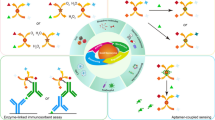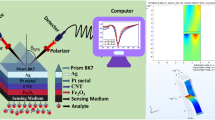Abstract
This study aimed to design a sandwich electrochemiluminescence (ECL) immunosensor with double co-reaction accelerators for sensitively detecting squamous cell carcinoma antigen (SCCA). First, silver orthophosphate (Ag3PO4) nanoparticles were modified on the surface of EuPO4 nanowires to improve their poor dispersibility/solubility. At the same time, EuPO4 was used as a co-reaction accelerator to catalyze S2O82− to produce more intermediates (SO4•−), significantly enhancing the ECL signal of Ag3PO4. Ag nanoparticles (AgNP) modified on Ag3PO4@EuPO4 composite nanomaterials were used not only as linkers of luminescence groups and biomarkers but also as a co-reaction accelerator to effectively enhance ECL signal. The designed ECL immunosensor displayed several advantages, including good stability and reproducibility. Under the optimal conditions, its linear range in detecting SCCA was 0.0001–50 ng·mL−1, the detection limit was 25 fg·mL−1 (S/N = 3), the recovery was 96.6–100.4%, and the relative standard deviation was less than 4.8%. It was successfully applied to detect SCCA in human serum.
Graphical Abstract







Similar content being viewed by others
References
RamezaniFarani M, Azarian M, Heydari Sheikh Hossein H, Abdolvahabi Z, MohammadiAbgarmi Z, Moradi A, Mousavi SM, Ashrafizadeh M, Makvandi P, Saeb MR, Rabiee N (2022) Folic acid-adorned curcumin-loaded iron oxide nanoparticles for cervical cancer. ACS Appl Bio Mater 5:1305–1318. https://doi.org/10.1021/acsabm.1c01311
Markovina S, Wang S, Henke LE, Luke CJ, Pak SC, DeWees T, Pfeifer JD, Schwarz JK, Liu W, Chen S, Mutch D, Wang X, Powell MA, Siegel BA, Dehdashti F, Silverman GA, Grigsby PW (2018) Serum squamous cell carcinoma antigen as an early indicator of response during therapy of cervical cancer. Br J Cancer 118:72–78. https://doi.org/10.1038/bjc.2017.390
Li Y, Zhang Y, Li F, Feng J, Li M, Chen L, Dong Y (2017) Ultrasensitive electrochemical immunosensor for quantitative detection of SCCA using Co3O4@CeO2-Au@Pt nanocomposite as enzyme-mimetic labels. Biosens Bioelectron 92:33–39. https://doi.org/10.1016/j.bios.2017.01.065
Ran C, Sun J, Qu Y, Long N (2021) Clinical value of MRI, serum SCCA, and CA125 levels in the diagnosis of lymph node metastasis and para-uterine infiltration in cervical cancer. World J Surg Oncol 19:343. https://doi.org/10.1186/s12957-021-02448-3
Cao X, Gu Y, Li Z, Ge S, Mao Y, Gu Y, Lu D (2023) A SERS microfluidic chip for ultrasensitive and simultaneous detection of SCCA and CYFRA21–1 in serum based on Au nanobowl arrays and hybridization chain reaction. Sensor Actuat B-Chem 375:132894. https://doi.org/10.1016/j.snb.2022.132894
Erickson JA, Lu J, Smith JJ, Bornhorst JA, Grenache DG, Ashwood ER (2010) Immunoassay for quantifying squamous cell carcinoma antigen in serum. Clin Chem 56:1496–1499. https://doi.org/10.1373/clinchem.2010.143156
Lin Y, Xu S, Yang J, Huang Y, Chen Z, Qiu B, Lin Z, Chen G, Guo L (2018) Interesting optical variations of the etching of Au Nanobipyramid@Ag Nanorods and its application as a colorful chromogenic substrate for immunoassays. Sensor Actuat B-Chem 267:502–509. https://doi.org/10.1016/j.snb.2018.04.060
Wu Y, Zhao Y, Wang Y, Ye X, Wu T, Deng H, Wu P, Li C (2017) Sensitive immunosensing of squamous cell carcinoma antigen based on a nanocomposite of poly{3-amine-N-[3-(N-pyrrole)propyl]imidazole bromide} ionic liquid and gold nanoroots. Biosens Bioelectron 96:140–145. https://doi.org/10.1016/j.bios.2017.04.028
Wei Q, Wang C, Zhou X, Wu T, Wang Y, Li C, Yang N (2019) Ionic liquid and spatially confined gold nanoparticles enhanced photoelectrochemical response of zinc-metal organic frameworks and immunosensing squamous cell carcinoma antigen. Biosens Bioelectron 142:111540. https://doi.org/10.1016/j.bios.2019.111540
Wang J, Wang H, Cao W, Zhang Q, Zhong W (2020) Synergistic amplification effect for electrochemiluminescence immunoassay based on dual coreactants coupling with resonance energy transfer. Talanta 212:120798. https://doi.org/10.1016/j.talanta.2020.120798
Babamiri B, Bahari D, Salimi A (2019) Highly sensitive bioaffinity electrochemiluminescence sensors: recent advances and future directions. Biosens Bioelectron 142:111530. https://doi.org/10.1016/j.bios.2019.111530
Qin D, Meng S, Wu Y, Mo G, Deng B (2022) Aggregation-induced electrochemiluminescence resonance energy transfer with dual quenchers for the sensitive detection of prostate-specific antigen. Sensor Actuat B-Chem 367:132176. https://doi.org/10.1016/j.snb.2022.132176
Wang H-M, Fang Y, Yuan P-X, Wang A-J, Luo X, Feng J-J (2019) Construction of ultrasensitive label-free aptasensor for thrombin detection using palladium nanocones boosted electrochemiluminescence system. Electrochim Acta 310:195–202. https://doi.org/10.1016/j.electacta.2019.04.093
Wang H-M, Wang A-J, Yuan P-X, Feng J-J (2020) Flower-like metal-organic framework microsphere as a novel enhanced ECL luminophore to construct the coreactant-free biosensor for ultrasensitive detection of breast cancer 1 gene. Sensor Actuat B-Chem 320:128395. https://doi.org/10.1016/j.snb.2020.128395
Hu S, Qin D, Meng S, Wu Y, Luo Z, Deng B (2022) Cathodic electrochemiluminescence based on resonance energy transfer between sulfur quantum dots and dopamine quinone for the detection of dopamine. Microchem J 181:107776. https://doi.org/10.1016/j.microc.2022.107776
Lv W, Ye H, Yuan Z, Liu X, Chen X, Yang W (2020) Recent advances in electrochemiluminescence-based simultaneous detection of multiple targets. TrAC Trends Anal Chem 123:115767. https://doi.org/10.1016/j.trac.2019.115767
Mo G, He X, Qin D, Meng S, Wu Y, Deng B (2021) Spatially-resolved dual-potential sandwich electrochemiluminescence immunosensor for the simultaneous determination of carbohydrate antigen 19–9 and carbohydrate antigen 24–2. Biosens Bioelectron 178:113024. https://doi.org/10.1016/j.bios.2021.113024
Wang J, Xu X, Zheng L, Guo Q, Nie G (2023) A signal “on–off-on”-type electrochemiluminescence aptamer sensor for detection of sulfadimethoxine based on Ru@Zn-oxalate MOF composites. Microchim Acta 190:131. https://doi.org/10.1007/s00604-023-05701-6
Huang L-Y, Hu X, Shan H-Y, Yu L, Gu Y-X, Wang A-J, Shan D, Yuan P-X, Feng J-J (2021) High-performance electrochemiluminescence emitter of metal organic framework linked with porphyrin and its application for ultrasensitive detection of biomarker mucin-1. Sensor Actuat B-Chem 344:130300. https://doi.org/10.1016/j.snb.2021.130300
Song X, Zhao L, Zhang N, Liu L, Ren X, Ma H, Luo C, Li Y, Wei Q (2022) Zinc-based metal–organic framework with MLCT properties as an efficient electrochemiluminescence probe for trace detection of trenbolone. Anal Chem 94:14054–14060. https://doi.org/10.1021/acs.analchem.2c03615
Zhang Y, Ju P, Sun L, Wang Z, Zhai X, Jiang F, Sun C (2020) Colorimetric determination of Hg2+ based on the mercury-stimulated oxidase mimetic activity of Ag3PO4 microcubes. Microchim Acta 187:422. https://doi.org/10.1007/s00604-020-04399-0
Song P, Wang M-L, Duan Y-X, Wang A-J, Xue Y, Mei L-P, Feng J-J (2023) Bifunctional photoelectrochemical aptasensor based on heterostructured Ag3PO4/Ag/TiO2 nanorod array for determination of two tumor markers. Microchim Acta 190:85. https://doi.org/10.1007/s00604-023-05654-w
Trench AB, Machado TR, Gouveia AF, Assis M, da Trindade LG, Santos C, Perrin A, Perrin C, Oliva M, Andrés J, Longo E (2018) Connecting structural, optical, and electronic properties and photocatalytic activity of Ag3PO4: Mo complemented by DFT calculations. Appl Catal B Environ 238:198–211. https://doi.org/10.1016/j.apcatb.2018.07.019
Khan MS, Ameer H, Ali A, Zhu W, Li X, Yang L, Wang H, Feng R, Wei Q (2019) Label-free electrochemiluminescent immunosensor for prostate specific antigen ultrasensitive detection based on novel luminophore Ag3PO4 decorated GO. J Electroanal Chem 847:113266. https://doi.org/10.1016/j.jelechem.2019.113266
Liang Y, Shang R, Lu J, Liu L, Hu J, Cui W (2018) Ag3PO4@UMOFNs Core–shell structure: two-dimensional MOFs promoted photoinduced charge separation and photocatalysis. ACS Appl Mater Interfaces 10:8758–8769. https://doi.org/10.1021/acsami.8b00198
Du X, Sun J, Li Y, Du W, Jiang D (2022) Self-accelerated electrochemiluminescence luminophor of Ag3PO4-Ti3C2 for trace lincomycin aptasensing. Microchem J 179:107578. https://doi.org/10.1016/j.microc.2022.107578
Song X, Zhao L, Luo C, Ren X, Wang X, Yang L, Wei Q (2022) Bioactivity-protective electrochemiluminescence sensor using CeO2/Co4N heterostructures as highly effective coreaction accelerators for ultrasensitive immunodetection. Sensor Actuat B-Chem 355:131158. https://doi.org/10.1016/j.snb.2021.131158
Wang C, Li Z, Ju H (2021) Copper-doped terbium luminescent metal organic framework as an emitter and a co-reaction promoter for amplified electrochemiluminescence immunoassay. Anal Chem 93:14878–14884. https://doi.org/10.1021/acs.analchem.1c03988
Yang L, Jia Y, Wu D, Zhang Y, Ju H, Du Y, Ma H, Wei Q (2019) Synthesis and application of CeO2/SnS2 heterostructures as a highly efficient coreaction accelerator in the luminol–dissolved O2 system for ultrasensitive biomarkers immunoassay. Anal Chem 91:14066–14073. https://doi.org/10.1021/acs.analchem.9b03796
Su C, Song Q, Jiang D, Dong C, Shan X, Chen Z (2021) An electrochemiluminescence aptasensor for diethylstilbestrol assay based on resonance energy transfer between Ag3PO4-Cu-MOF(ii) and silver nanoparticles. Analyst 146:4254–4260. https://doi.org/10.1039/D1AN00599E
Mo G, Qin D, Jiang X, Zheng X, Mo W, Deng B (2020) A sensitive electrochemiluminescence biosensor based on metal-organic framework and imprinted polymer for squamous cell carcinoma antigen detection. Sensor Actuat B-Chem 310:127852. https://doi.org/10.1016/j.snb.2020.127852
Xue J, Yang L, Jia Y, Wang H, Zhang N, Ren X, Ma H, Wei Q, Ju H (2019) Electrochemiluminescence double quenching system based on novel emitter GdPO4: Eu with low-excited positive potential for ultrasensitive procalcitonin detection. ACS Sens 4:2825–2831. https://doi.org/10.1021/acssensors.9b01552
Ma H, Zhou J, Li Y, Han T, Zhang Y, Hu L, Du B, Wei Q (2016) A label-free electrochemiluminescence immunosensor based on EuPO4 nanowire for the ultrasensitive detection of Prostate specific antigen. Biosens Bioelectron 80:352–358. https://doi.org/10.1016/j.bios.2016.01.069
Zhou M, Pu Y, Wu Q, Wang P, Liu T, Zhang M (2020) 2D hexagonal SnS2 nanoplates as novel co-reaction accelerator for construction of ultrasensitive g-C3N4-based electrochemiluminescent biosensor. Sensor Actuat B-Chem 319:128298. https://doi.org/10.1016/j.snb.2020.128298
Jiang M-H, Lu P, Lei Y-M, Chai Y-Q, Yuan R, Zhuo Y (2018) Self-accelerated electrochemiluminescence emitters of Ag@SnO2 nanoflowers for sensitive detection of cardiac troponin T. Electrochim Acta 271:464–471. https://doi.org/10.1016/j.electacta.2018.03.177
Tu T-T, Lei Y-M, Chai Y-Q, Zhuo Y, Yuan R (2020) Organic dots embedded in mesostructured silica xerogel as high-performance ECL emitters: preparation and application for MicroRNA-126 detection. ACS Appl Mater Interfaces 12:3945–3952. https://doi.org/10.1021/acsami.9b17751
Chai D-D, Zhuo Y, Tu T-T, Li H-L, Yuan R, Wei S-P (2022) Ag@Pyc nanocapsules as electrochemiluminescence emitters for an ultrasensitive assay of the APE1 activity. Anal Chem 94:9934–9939. https://doi.org/10.1021/acs.analchem.2c02122
Nie Y, Tao X, Zhou Y, Yuan X, Zhuo Y, Chai Y, Yuan R (2021) Kill three birds with one stone: poly(3,4-ethylenedioxythiophene)-hosted Ag nanoclusters with boosted cathodic electrochemiluminescence for biosensing application. Anal Chem 93:1120–1125. https://doi.org/10.1021/acs.analchem.0c04165
Acknowledgements
We acknowledge the support from the National Natural Science Foundation of China (22164004), the Guangxi Science Foundation of China (2022GXNSFDA035069) and Innovation Project of Guangxi Graduate Education (YCSW2023194).
Author information
Authors and Affiliations
Corresponding author
Ethics declarations
Conflict of interest
The authors declare no competing interests.
Additional information
Publisher's note
Springer Nature remains neutral with regard to jurisdictional claims in published maps and institutional affiliations.
Supplementary Information
Below is the link to the electronic supplementary material.
Rights and permissions
Springer Nature or its licensor (e.g. a society or other partner) holds exclusive rights to this article under a publishing agreement with the author(s) or other rightsholder(s); author self-archiving of the accepted manuscript version of this article is solely governed by the terms of such publishing agreement and applicable law.
About this article
Cite this article
Xu, L., Hu, S., Qin, D. et al. An electrochemiluminescence immunosensor with double co-reaction accelerators based on Ag3PO4@EuPO4-AgNP for detecting squamous cell carcinoma antigen. Microchim Acta 190, 223 (2023). https://doi.org/10.1007/s00604-023-05793-0
Received:
Accepted:
Published:
DOI: https://doi.org/10.1007/s00604-023-05793-0




